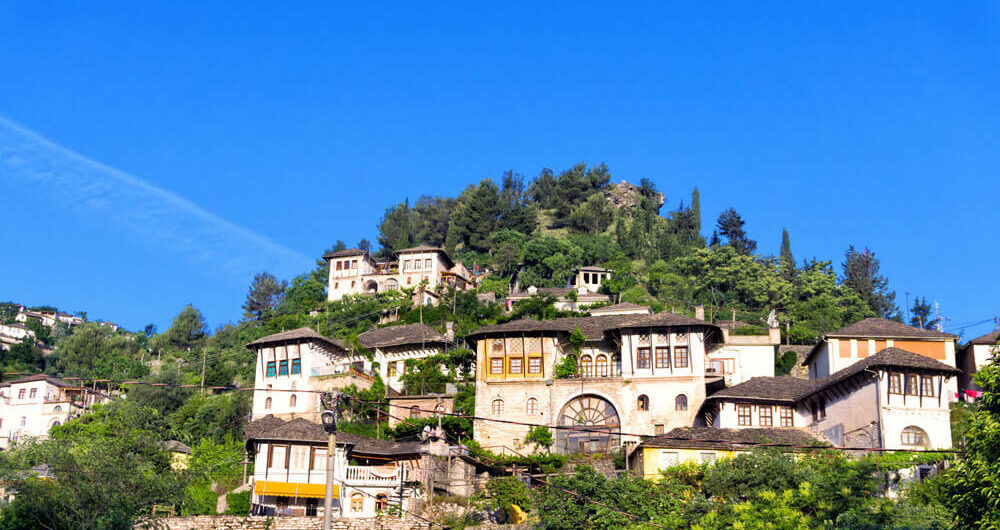Hidden in the beautiful countryside of southern Albania lies Gjirokaster, a city rich in culture, history, and natural splendor. Although often overlooked by more well-known cities, Gjirokaster remains a hidden treasure waiting for adventurous travelers to explore. Many compelling reasons make this charming city worth including in your travel plans.
The timeless architecture of Gjirokaster
Gjirokaster boasts timeless architecture, showcasing an amazing collection of Ottoman architecture and earning the title “The City of Stone.” Moreover, the well-preserved stone homes, decorated with wooden balconies, create a stunning atmosphere.
1- House of Zakat:
Perched somewhat on the mountain slope with a roof resembling a tin hat from the 1930s, the House of Zakat casts a shadow and is considered the best example of a typical Ottoman tower. Additionally, it features lower floors built of stone for safety reasons and main rooms showcasing decorated walls and ornate fireplaces.
2-The house of Skëndulatë:
Next to the ethnographic museum stands the House of Skëndulatë, which has passed the test of time despite being over 250 years old. Additionally, the tall building is supported by stone foundations reaching the windows of the first floor. It features finely crafted ceilings and a unique construction model that adds to its historical charm.
Gjirokaster Castle:
Perched on a hill overlooking the town, is a strong fortress with a time-tested history dating back to the 12th century. Guests can take in breathtaking perspectives of the surrounding landscape while exploring its medieval ramparts and underground dungeons, showcasing its crucial role in shaping Albania’s history.
The rich heritage of the culture:
Perched on a hill overlooking the town, the strong fortress of Gjirokaster Castle has a time-tested history dating back to the 12th century. Guests can take in breathtaking perspectives of the surrounding landscape. Additionally, they can explore its medieval ramparts and underground dungeons, showcasing its crucial role in shaping Albania’s history.
Albanian Folk Iso Polyphony
Designated as a “Masterpiece of the Oral and Spiritual Heritage of Humanity” by UNESCO, Albanian Folk Iso Polyphony stands as the most recognized Albanian cultural heritage phenomenon internationally. In addition, it serves as a testament to Albania’s rich and diverse cultural legacy.
The birthplace of Ismail Kadare:
Literature enthusiasts will particularly appreciate Gjirokaster as the birthplace of Ismail Kadare, Albania’s most renowned writer and Man Booker International Prize winner. Moreover, his childhood home, transformed into an exhibit, offers valuable insights into Albania’s literary history.
The birthplace of Enver Hoxha:
Enver Hoxha, the former leader of Albania, was born in Gjirokastër, with his birthplace now a museum dedicated to his life and legacy. Furthermore, the house, a traditional Ottoman-style stone structure, is situated in the historic center, surrounded by narrow cobblestone streets and historic buildings.
Natural Beauty:
Gjirokaster’s natural beauty, characterized by green valleys, rolling hills, and crystal-clear rivers, offers abundant opportunities for outdoor adventures and eco-tourism initiatives. Moreover, the area’s beauty is unspoiled, providing the ideal setting for outdoor enthusiasts and eco-conscious travelers alike.
Mount Çajup
Mount Çajup, a prominent peak near the city, stands at an elevation of approximately 1,824 meters. Moreover, it is a popular destination for hikers and outdoor enthusiasts. The area around Mount Çajup offers breathtaking panoramic views of the surrounding landscape, including the valleys, rivers, and villages that dot the countryside below.
Warm Hospitality:
A major part of a trip to Gjirokaster is the authentic Hospitality of the locals. When sampling homemade food in a local taverna or chatting with a helpful shopkeeper, Visitors are warmly welcomed into the bustle of daily life. This feeling of camaraderie and community leaves a lasting impression on tourists even after leaving the city.
Cuisine:
Gjirokastra’s traditional cuisine, passed down through generations, includes dishes like pasha qofte and shapkat, showcasing the rich flavors and cooking elements unique to the region.The culture of mahogany is a tradition passed down through the generations, not only on the tables of the stone city, but also in the surrounding areas.
Pasha qofte:
If you pass once in Gjirokastër, don’t leave without trying the famous pasha qofte of this area. It is called so because it was cooked for Ali Pasha Tepelena and the composition is rice meatballs, cooked in white or red sauce. It is simple to prepare, but full of taste when consumed, it was not for nothing that it was Ali Pasha’s favorite. T
Shapkat:
Another popular recipe from this area is Shapkat, also known as cabbage with corn flour or pispili. It represents a typical dish that generations have preserved and continues to be full of flavor even today.
Gjirokaster offers a captivating mix of history, culture, and natural beauty that’s certain to impress even the most experienced travelers. Exploring its quaint streets, taking in panoramic views from the Castle walls, or immersing oneself in the vibrant cultural landscape encourages exploration and curiosity. So why delay? Take a trip to Gjirokaster and experience the wonder of Albania’s hidden treasure.





